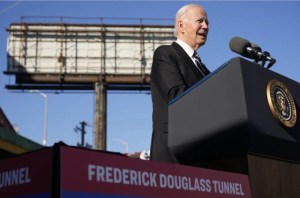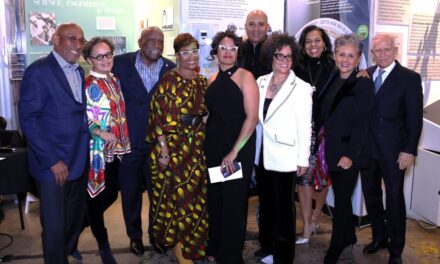By Chris Megerian,
The Associated Press
Greeted by the cheerful blare of a train horn, President Joe Biden stood Monday before a decrepit rail tunnel that he estimated he’s been through 1,000 times — fearing for decades it might collapse.
“For years, people talked about fixing this tunnel,” Biden told a crowd in Baltimore. “Back in the early ’80′s, I actually walked into the tunnel with some of the construction workers. … This is a 150-year-old tunnel. You wonder how in the hell it’s still standing.”
“With the bipartisan infrastructure law, though, we’re finally getting it done.”
The president came to familiar terrain to promote his 2021 infrastructure law, a bipartisan win that is just now ramping up the spending on major projects.
Biden said replacing the Baltimore and Potomac Tunnel could slash what’s now a 60-minute Baltimore-to-Washington commute in half, giving daily riders extra time with family and friends.
As a senator, the president regularly journeyed home to Delaware on Amtrak through the tunnel. He rode “15% of the time with engineers,” he said, and had a key to get into the back of the trains.
The new tunnel will lead to 20,000 construction jobs and cut down on auto traffic and pollution, he said, “jobs for folks I used to think about as I took the train home at night.”
The tunnel, first opened in 1873 when Ulysses S. Grant was president, connected Philadelphia and Washington by rail for the first time. But over time, it became more of a chokepoint than a lifeline. There’s only one tube, and trains need to slow to just 30 mph (48 kilometers per hour) to navigate a tight turn on the southern end.
Once completed roughly a decade from now, the new tunnel is expected to have two tubes, with up to four tracks total, and allow trains to travel more than 100 mph. It will be named for Frederick Douglass, who escaped from slavery in Maryland and became a prominent abolitionist. The total project, which includes related bridges and equipment modernization, could cost $6 billion.
Biden also announced labor agreements intended to smooth the tunnel’s completion and ensure good wages for union workers, according to the White House. Maryland has also agreed to commit $450 million for construction.
No money has yet been awarded from the federal infrastructure legislation. However, the law signed by Biden includes $24 billion for rail improvements along the Northeast Corridor, and up to $4.7 billion could be provided for the Baltimore tunnel, covering the majority of its cost.
Even as multiple Maryland officials attended Biden’s speech, there is some local opposition to the new tunnel. The group Residents Against the Tunnels (RATT) opposes the project out of concern that the construction, use of the tunnel for freight and noise and vibration from passing trains would be detrimental to the neighborhood located above.
But for those who know the president from his time on the train, the project reflects an approach hard earned over years of commuting challenges.
Gregg Weaver, 69, got to know Biden while working as a conductor during a 42-year career with Amtrak. When he was working the morning shift on a southbound train, sometimes they would have to hold at Baltimore Penn Station because of trouble ahead at the tunnel.
“How’s it look?” Biden would ask as he pondered his schedule on Capitol Hill.
“The tunnel can really complicate the whole thing,” said Weaver, who retired in 2013. “It’s a bottleneck.”
As for Biden, “he rode so much, he probably experienced everything there is to experience,” Weaver said.
Baltimore is the first of three trips this week that Biden has dedicated to infrastructure. On Tuesday, he will travel to New York to talk about plans for another new rail tunnel, this one under the Hudson River.
On Friday, Biden is headed to Philadelphia, where the Democratic National Committee is also holding its winter meeting to finalize the party’s primary schedule. He will be joined by Vice President Kamala Harris, and the White House says his remarks will focus on replacing lead pipes, another key part of the infrastructure legislation.
Roughly 200,000 people rode through the Baltimore tunnel every workday before the COVID-19 pandemic. But because there are only two tracks, any maintenance or problem threatened to severely constrict travel.
Besides building a new tunnel, the project would rehabilitate the existing version. It was damaged by corrosive salt water that flooded in during Hurricane Sandy in 2012.
Help us Continue to tell OUR Story and join the AFRO family as a member –subscribers are now members! Join here!
The post ‘Amtrak Joe’ Biden hails plans for big East Coast tunnel fix appeared first on AFRO American Newspapers .











